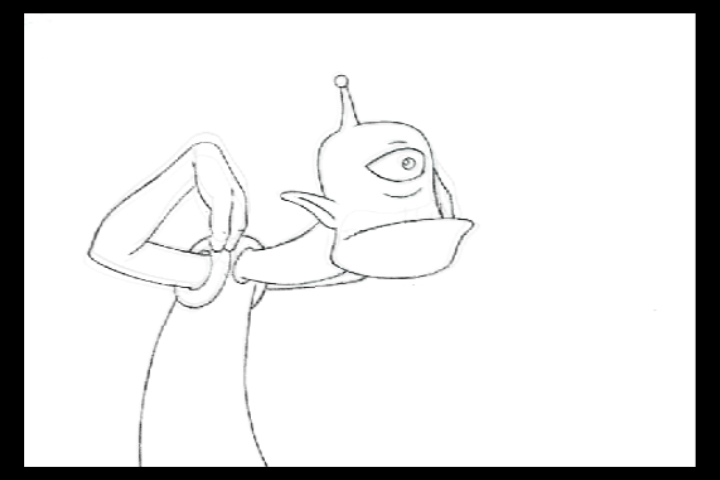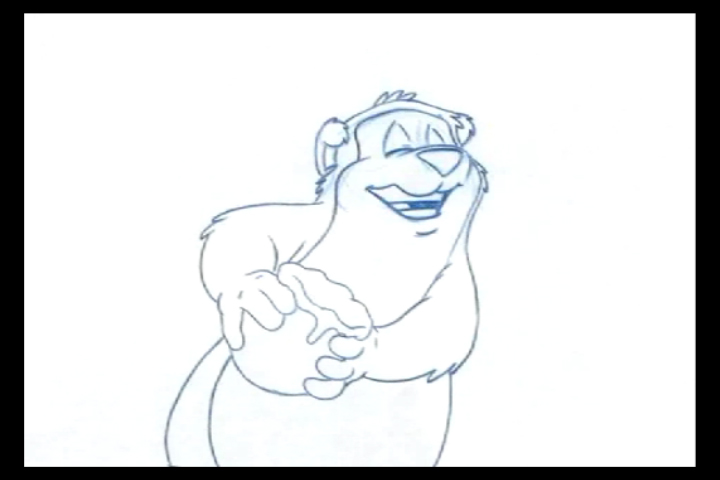Animation
Assignment#2
"Absolutely Incredible"
Using the sound tracks provided, choose one and animate a character in a slight 3/4 front view, saying the two words, “Absolutely incredible”. You are to breakdown the soundtrack and fill in the exposure sheets appropriately. These will be checked over by Brian in the Week 4 class
The character is to be drawn from the mid chest up. Use the character’s entire upper torso when animating the delivery of the line. You need to have the character making an appropriate hand gesture in this assignment. Concentrate on the facial expressions, mouth positions, anticipation, action and reaction of the character. Make sure the gesture is complimentary to the line being delivered.
The character should be in a state of action appropriate to what you want the character to be doing before they deliver their line. They may be staring at something, thinking about something, or reacting to something. This must take place first. The character then delivers the line, “Absolutely incredible” and then recovers in an appropriate manner.
Shoot the animation as a line test showing 3 cycles. When you match it up to the sound in premier, the final hand-in must match the following parameters EXACTLY.
• 2 seconds of black screen.
• 4 seconds of your name slate created using clear readable fonts in Photoshop on a white
background (no hand drawn names).
• 1 second hold of the first drawing (should be an "animated hold") at the beginning of the scene - the animation assignment - 1 second hold of the last drawing at the end (should be an "animated hold") - cycle 3 times only (no name slates in between).
• 2 seconds of black screen.
Submit as an .avi file labeled with your last name first and first name last.
If you are a "Keener" and want to plan this out so that it links up with your "Single Sentence" assignment, I'm o.k. with that. The character would be reacting to whatever the character in the single sentence assignment is doing off screen and then you'd cut to the single sentence character and they would deliver their line. Or, you could have it so the character saying "Absolutely incredible" comes after the character from the single sentence assignment. This doesn't add any extra work, you just need to plan it with the connection in mind.
If you want to be a "Super Keener", you could plan this to link up with your "Single Sentence" assignment and the "Two Character" assignment to make one gigantic lip sync that all strings together. Again, this doesn't add any extra work, it's just a bit of pre-planning.
Principles Involved
• Thumbnailing
• Scene Planning
• Lip Synchronization
• Keys
• Inbetweens
• Timing
• Slo in & Slo out
• Stretch & Squash
• Overlapping Action
• Effects of Gravity
• Weight
• Realistic Timing
• Use of Arcs
• Observation
• Flipping
Deadline
Beginning of class - Week 6, 1st semester
Grading
Assignment is worth 20% of the first semester grade
Animation will be graded in the following areas:
• Strong Key Posing
• Appropriate, Realistic Timing
• Proper Anticipation, Action, Reactions
• Overlapping Action
• Structural, three dimensional drawing
• Proper use of mouth positions
The animation must show appropriate squash and stretch, realistic timing, proper slo-in and slo-out, torque, tilt, and twist in the head and shoulders as per in-class lecture demonstration. Character must appear to be saying the words being animated.
Thought Process
In this assignment you are beginning the process of understanding sound and picture synchronization with two words, “Absolutely incredible”. There are 34 tracks to choose from, each one a different delivery and vocal type. The focus in this assignment is on the acting and expression used by the character. Using body language and posture to convey an emotion. After you have chosen your track, you'll have to breakdown the sound onto the exposure sheets.
In class, listen to the track you have chosen. Listen to the inflection of the voice and how the words are pronounced. Each track has a different timing and pace. This will be reflected on your X-sheet as you write the sounds onto the corresponding frames. *NOTE: the timing on the X-sheet is based on 30 frames per second. Each page of the X-sheet represents one second of screen time. Be sure to make the adjustment in the Lunchbox when you are shooting your animation pencil tests.
Now you must decide on how the character is going to perform these two words most effectively. Begin to think about what the character is doing as they deliver these words. What are they thinking about. What has happened just before? What might happen after? Find a specific accent or accents within the delivery and make a note of them on the X-sheet.
On a clean sheet of paper, draw a series of quick sketches showing the key poses through the dialogue (you should need no more than 5 - 10 for this assignment). Refine and edit the poses until you find the appropriate action. Lable these poses ‘A’, ‘B’, ‘C’, ‘D’, etc. in their proper order. On the X-sheet find the frame where each particular pose would hit and write it in in the “Action” column. These are now your “Primary Keys”.

Go to your animation desk and redraw these key poses at full size. Add in all secondary keys for anticipation, reactions, and recovery. Next add in any breakdowns for broad actions. Shoot your pencil test based on the timing indicated on the X-sheet.
After the pencil test has been reviewed, make any revisions to the keys and breakdowns as are necessary to make the animation work the best. When you add in extra drawings label them with the letter and then a number, depending on how many you're putting in.

After this has been approved, write in the drawing numbers on the X-sheet. You can then change the letters on each drawing to the appropriate number that corresponds on the X-sheet. Then depending on how many drawings are inbetween each key, you can fill in the final timing charts with the appropriate slo-in, slo-out, constant rate or cushons.
Draw all your inbetweens and shoot (or scan) the final animation, then import it into the computer using Premier. Import the vocal track and match it up to the animation.
Some Basic Things To Think About
1) What is the point or purpose of this scene
2) What is the point or purpose of this scene within the sequence
3) Look at your storyboard. Without dialogue, what are you showing about your character
4) Plan all gestures and actions to be read and understood by the audience (Silhouette, Line of action, Acting, etc.)
5) Gestures do not have just “meaning”, they should have “appropriate meaning” that can be understood by all people.
6) Although body gesture is often more important to an animator, facial expression is the logical center of interest to the audience. (We look at another person’s eyes.)
7) Body gesture establishes the idea, facial expression clarifies, refines or punctuates it.
8) Dialogue should not be used as a crutch. We are trying to express thoughts visually through gesturing.
9) Telegraphing... show it in the body before speaking it.
10) Don’t move too much or try to do too much. To show expression is far more important than movement.
11) Take the time to show the expression change. Don’t loose it amongst the characters actions.
12) Much of the expression change (like action) is accomplished not in the actual change itself, but in the difference, or contrast between the two related expressions.
13) Don’t start your animation without a clear idea of the acting and staging after doing your thumbnails. Many times you will find that you’ve done too much and overacted. Don’t be afraid to take out a few poses to tone the action down.
14) Mentally rehearse at actual speed (not slow motion) your gestural phrases.
15) Analyse your own mouth in the mirror (both in slow motion and at actual speed).
16) Who’s dialogue is it? Yours or the character’s? Draw mouth shapes that fit the personality of the character.
Remember!
“We are not just illustrating words, we are animating thoughts and ideas. The way a character walks, stands, sits, listens will reveal the meaning of their words. What we strive for is ACTING, not ACTION. You are not just moving mouths or flapping lips, you are trying to make them act and that includes every drawing in your scene, not just the key poses... they have all got to have that feeling of acting.”
- Ollie Johnston
Character Design
The character design is of your choice and should suit the vocal sound track unless you want to go for an "opposite effect" where the character is a huge hulking monster but has the high pitched voice or the character is a small, cute "baby type" but has a low pitched voice.
Scheduling
Week 3 Class
• Lecture on how to key animate from an exposure sheet - Demo - 1 hour.
• Demo in computer lab on how to break down a soundtrack using Premier - 1 hour.
• Get copy of sound track
• Begin Soundtrack breakdown and exposure sheet fill-in (Must be completed by next class).
• Begin key animation (must be completed by next class for review).
Week 4 Class
• Viewing “Meow” assignment and critiques - 1 hour.
• Hand back grades
• Checklist for exposure sheets (10% deduction for failure to show during class period).
• Review key animation (30% deduction for failure to show during class period).
• Begin breakdowns and inbetweens (must be completed by next class for review).
Week 5 Class
• Lecture on Lip Sync - 1 hour.
• Reviewing keys and breakdowns and inbetweens (30% deduction for failure to show during class period).
• Revisions as necessary
Week 6 Class
• Hand in assignment at beginning of class (A 10% deduction will be made if the assignment is not submitted in the required format exactly as outlined above).
• Lecture on Single Sentence Assignment
Go to Sound Tracks

This is something you won't get from an in class lecture.
$29.00 US (shipping included)

Watch the pencil test shot on "twos"

Watch the pencil test shot on "ones"

Watch the final color animation

Watch the pencil test of the bear keys

